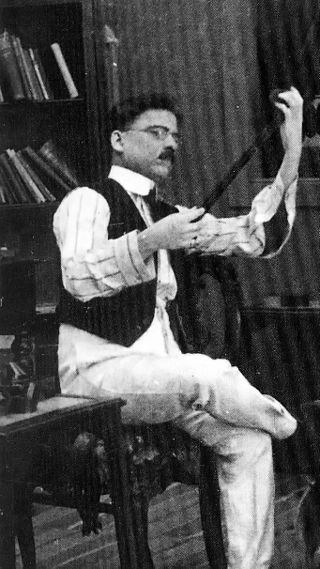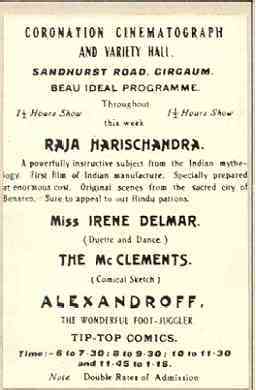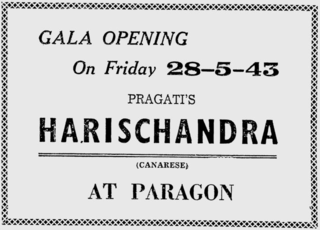Trymbak B. Telang was an early Indian cinematographer. He was trained in the operation of the Williamson camera. [1] He shot for films such as Raja Harishchandra (1913) [2] and Satyavadi Raja Harishchandra and Lanka Dahan (1917).
Trymbak B. Telang was an early Indian cinematographer. He was trained in the operation of the Williamson camera. [1] He shot for films such as Raja Harishchandra (1913) [2] and Satyavadi Raja Harishchandra and Lanka Dahan (1917).

Harishchandra is a legendary king of the Solar dynasty, who appears in several legends in texts such as the Aitareya Brahmana, Mahabharata, the Markandeya Purana, and the Devi Bhagavata Purana. The most famous of these stories is the one mentioned in the Markandeya Purana. According to this legend, Harishchandra gave away his kingdom, sold his family, and agreed to be a slave – all to fulfill a promise he had made to the sage Vishvamitra.

Dhundiraj Govind Phalke, popularly known as Dadasaheb Phalke, was an Indian producer-director-screenwriter, known as "the Father of Indian cinema". His debut film, Raja Harishchandra, was the first Indian movie released in 1913, and is now known as India's first full-length feature film. He made 95 feature-length films and 27 short films in his career, spanning 19 years, until 1937, including his most noted works: Mohini Bhasmasur (1913), Satyavan Savitri (1914), Lanka Dahan (1917), Shri Krishna Janma (1918) and Kaliya Mardan (1919).

Raja Harishchandra is a 1913 Indian silent film directed and produced by Dadasaheb Phalke. It is often considered the first full-length Indian feature film. Raja Harishchandra features Dattatraya Damodar Dabke, Anna Salunke, Bhalchandra Phalke, and Gajanan Vasudev Sane and is based on the legend of Harishchandra, with Dabke portraying the title character. The film, being silent, had English, Marathi, and Hindi-language intertitles.

Marathi cinema is an Indian film industry of Marathi-language motion pictures. It is based in Mumbai and Pune. Kolhapur was another centre of active film production in the twenties. It is the oldest film industry of Indian cinema. The first Marathi film to be released in India was Shree Pundalik by Dadasaheb Torne on 18 May 1912 at Coronation Cinematograph, Mumbai. and a Marathi crew who were performing Marathi and Sanskrit Sangeet natikas (musicals) and plays in Marathi at that period.
D. D. Dabke or Dattatraya Damodar Dabke was an actor in the first ever Indian full length silent film Raja Harishchandra, directed by Dadasaheb Phalke in 1913. He co-starred with Anna Salunke. He acted in three more movies Satyavadi Raja Harishchandra (1917), Lanka Dahan (1917), Shri Krishna Janma (1918) and later became a cinematographer, as well as a director. He directed the 1924 remake of Raja Harishchandra

Jamshedji Framji Madan, professionally known as J. F. Madan, was an Indian theatre and film magnate who was one of the pioneers of film production in India, an early exhibitor, distributor and producer of films and plays. He accumulated his wealth on the Parsi theatre district scene in Bombay in the 1890s where he owned two theatre companies. He moved to Calcutta in 1902 where he founded Elphinstone Bioscope Company, and began producing and exhibiting silent movies including Jyotish Sarkar's Bengal Partition Movement in 1905. He expanded his empire considerably after acquiring rights to Pathé Frères films. He produced Satyavadi Raja Harishchandra in 1917 and Bilwamangal in 1919. Satyavadi Raja Harishchandra was the first feature film to be shot in Calcutta. Elphinstone merged into Madan Theatres Limited in 1919 which brought adapted many of Bengali's most popular literary works to the stage. Madan Theatres was a major force in Indian theatre throughout the 1920s and 1930s.
Coronation Cinematograph and Variety Hall was a hall in the Girgaon area of south Mumbai, India used for variety entertainment shows, dramas and to screen movies.

Satyawadi Raja Harishchandra is a 1917 silent black and white Indian film based on Hindu mythology, directed by Rustomji Dhotiwala. It was produced by J. F. Madan's Elphinstone Bioscope. Credited as the first remake in Indian cinema, the film is a remake of the first Indian feature film, Raja Harishchandra (1913) and was also inspired by an Urdu language drama, Harishchandra. The film is based on the mythological story of a Hindu King Harishchandra, the 36th king of the Solar Dynasty, who donated his entire kingdom and sold himself and his family to keep the promise given to the sage Vishvamitra in the dream. It is also the first feature film made in Calcutta. The intertitles used in the film were in Bengali language as the film was a silent film. The film was released on 24 March 1917 at New Tent Maidan, Calcutta.

Satya Harishchandra is a 1965 Indian Telugu-language Hindu mythological film, based on the life of Harishchandra, produced and directed by K. V. Reddy under the Vijaya Productions banner. It stars N. T. Rama Rao and S. Varalakshmi, with music composed by Pendyala Nageswara Rao.
The Indian Animation Industry encompasses traditional 2D animation, 3D animation and visual effects for feature films. In 1956, Disney Studios animator Clair Weeks, who had worked on Bambi, was invited to Films Division of India in Mumbai to establish and train the country's first animation studio as part of the American technical co-operation mission. He trained a core group of Indian animators, whose first production was a film called The Banyan Deer (1957). Veteran animator Ram Mohan started his career at Films Division's Cartoon Unit.

Ayodhyecha Raja, literally "The King of Ayodhya", was the first Marathi talkie, released in 1932, directed by Shantaram Rajaram Vankudre. It is based on the mythological story of Raja Harishchandra of Ayodhya and his test by sage Vishwamitra, as recounted in Valmiki's epic, Ramayana.
Harishchandra is an Indian king mentioned in ancient Hindu religious texts.

Shree Pundalik, which was released on 18 May 1912 at the Coronation Cinematograph, Girgaum, Mumbai, is sometimes considered the first feature-length Indian film by a minority. The government of India and most scholarly sources consider Raja Harishchandra to be the first Indian feature film, and detractors argue Pundalik was only a photographic recording of a popular play. It was produced and directed by Dadasaheb Torne.
Satyavadi Raja Harishchandra is a 1917 silent black and white Indian short film directed and produced by Dhundiraj Govind Phalke. The film is a shorter version of the first Indian feature film, Raja Harishchandra (1913), also directed and produced by Phalke. The intertitles used in the film were in Marathi language as the film was a silent film. The film is based on the mythological story of a Hindu King Harishchandra, the 36th king of the Solar Dynasty, who donated his entire kingdom and sold himself and his family to keep the promise given to the sage Vishvamitra in the dream.

Lanka Dahan is a 1917 Indian silent film directed by Dadasaheb Phalke. Phalke also wrote the film based on an episode of the Hindu epic Ramayana, credited to Valmiki. The film was Phalke's second feature film after the 1913 Raja Harishchandra, which was the first Indian full-length feature film. Phalke also directed various short films in between.

Satya Harishchandra is a 1943 Indian Kannada-language film directed by R. Nagendra Rao. It stars Subbaiah Naidu, Lakshmibai and Rao. The music of the film was composed by R. Sudarshanam. The film was successful at the box office and ran for 100 days in Dharwad. The movie was dubbed in Tamil making it the first Kannada movie to be dubbed in other language.

Anna Hari Salunke, also known as A. Salunke and Annasaheb Saluke, was an Indian actor who performed female roles in very early Indian cinema and also a cinematographer. He is credited as the first person to perform as a heroine in Indian cinema when he played the role of Rani Taramati of King Harishchandra in Dada Saheb Phalke's first full-length film, Raja Harishchandra (1913). In 1917, Salunke became the first to play a double role in Indian cinema, by playing the roles of both the hero and heroine in Lanka Dahan.
Harishchandra is a 1932 Tamil mythological film directed by Raja Chandrasekhar and Sarvottam Badami for Sagar Movietone. T.C. Vadivelu Naicker is another name cited as an earlier co-director. The film was the third Tamil Talkie produced. The first Tamil talkie was Kalidas (1931) produced by Imperial Movietone and directed by H. M. Reddy in 1931. The second Tamil sound film was Galava Rishi produced by Sagar Movietone and directed by Sarvottam Badami. The cast included Nungambakkam Janaki and Rukmini.
The history of animation in India can be traced to the early 20th century. Precursors to modern animation such as shadow puppets and slide shows entertained audiences before the advent of the cinema. Pioneers such as Dadasaheb Phalke, Gunamoy Banerjee, K.S. Gupte and G.K. Ghokle kept the tradition of animation alive during the first half of the 20th century. Such individuals were usually self-taught and were inspired by foreign cartoons.